Borzoi
This article includes a list of general references, but it remains largely unverified because it lacks sufficient corresponding inline citations. (March 2014) |
| Borzoi | |||||||||||||||||||||||||||||||||
|---|---|---|---|---|---|---|---|---|---|---|---|---|---|---|---|---|---|---|---|---|---|---|---|---|---|---|---|---|---|---|---|---|---|
 A Borzoi | |||||||||||||||||||||||||||||||||
| Other names |
| ||||||||||||||||||||||||||||||||
| Origin | Russia | ||||||||||||||||||||||||||||||||
| |||||||||||||||||||||||||||||||||
| |||||||||||||||||||||||||||||||||
| Dog (domestic dog) | |||||||||||||||||||||||||||||||||
The Borzoi (borzaya, meaning 'sighthound' in Russian), also called the Russian Hunting Sighthound (Russian: ру́сская псовая борзая, romanized: russkaya psovaya borzaya 'Russian long-haired sighthound') and known as the Russian Wolfhound until 1936,[1] is a sighthound hunting breed of domestic dog. They are descended from the working dogs of people who migrated from Central Asian countries to what is now considered Russia prior to the 17th century.
The system by which Russians over the ages named their sighthounds was a series of descriptive terms, not actual names. Borzói is the masculine singular form of an archaic Russian adjective that means 'fast'. Borzáya sobáka ('Fast dog') is the basic term for sighthounds used by Russians, though sobáka is usually dropped. The name psovaya derived from the word psovina, which means 'wavy, silky coat', just as hortaya (as in hortaya borzaya) means shorthaired. In modern Russian, the breed commonly called the Borzoi is officially known as russkaya psovaya borzaya. Other Russian sighthound breeds are stepnaya borzaya (from the steppe), called stepnoi; and krimskaya borzaya (from the Crimea), called krimskoi.
The most commonly used plural form is the regular formation Borzois, which is the only plural cited in most dictionaries.[2][3] However, the Borzoi Club of America and the Borzoi Club UK[4] both prefer Borzoi as the form for both singular and plural forms.
Description[]

Appearance[]
Borzois are large Russian sighthounds that resemble some central Asian breeds such as the Afghan hound, Saluki, and the Kyrgyz Taigan. Borzois come in virtually any colour.[5] The Borzoi coat is silky and flat, often wavy or slightly curly. The long top-coat is quite flat, with varying degrees of waviness or curling. The soft undercoat thickens during winter or in cold climates, but is shed in hot weather to prevent overheating. In its texture and distribution over the body, the Borzoi coat is unique. There should be a frill on its neck, as well as feathering on its hindquarters and tail.[6]
Borzoi males frequently weigh more than 100 pounds (45 kg). Males stand at least 30 inches (76 cm) at the shoulder, while the height of females is around 26 inches (66 cm). Despite their size, the overall impression is of streamlining and grace, with a curvy shapeliness and compact strength.

Black Borzoi
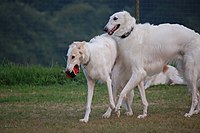
Yellow and white, and white Borzois
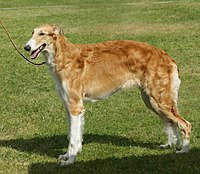
Red and white Borzoi
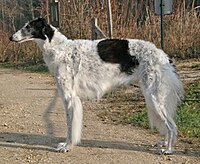
Black and white Borzoi
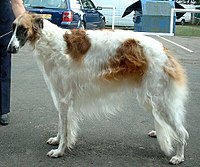
White and brown Borzoi
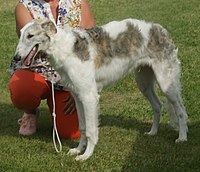
White and grey Borzoi
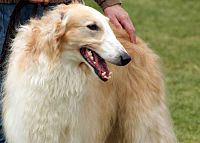
Borzoi, white and sandy coloured coat
Temperament[]


The Borzoi is an athletic and independent breed of dog. Most Borzois are fairly quiet, barking on rare occasions. They do not have strong territorial drives and cannot be relied on to raise the alarm upon sighting a human intruder. The Borzoi requires patient, experienced handling.[1] They are gentle and highly sensitive dogs with a natural respect for humans. Borzois do not generally display dominance or aggression towards people, but can turn aggressive if handled roughly. Typically, they are rather reserved with strangers but affectionate with people they know well. Their sensitivity to invasion of their personal space can make them nervous around children unless they are brought up with them. Borzois adapt well to suburban life, provided they have a spacious yard and regular opportunities for free exercise.[citation needed]
In terms of obedience, Borzois are selective learners who quickly become bored with repetitive, apparently pointless, activity, and they can be very stubborn when they are not properly motivated. For example, food rewards, or "baiting", may work well for some individuals, but not at all for others. Nevertheless, Borzois are definitely capable of enjoying and performing well in competitive obedience and agility trials with the right kind of training.[7][8][9] Like other sighthounds, they are very sensitive and do not cope well with harsh treatment or training based on punishment, and will be extremely unhappy if raised voices and threats are a part of their daily life. However, like any intelligent dog, Borzois respond extremely well to the guidance, support, and clear communication of a benevolent human leadership.
Borzois were bred to pursue or "course" game and have a powerful instinct to chase things that run from them, including cats and small dogs.[citation needed] Built for speed and endurance, they can cover long distances in a very short time. A fully fenced yard is a necessity for maintaining any sighthound.[citation needed] They are highly independent and will range far and wide without containment, with little regard for road traffic. For off-leash exercise, a borzoi needs a very large field or park, either fully fenced or well away from any roads, to ensure its safety.
Borzois are born with specialized coursing skills, but these are quite different from the dog-fighting instincts seen in some breeds. It is quite common for Borzois at play to course (i.e., run down) another dog, seize it by the neck and hold it immobile. Young pups do this with their littermates, trading off as to who is the prey. It is a specific hunting behavior, not a fighting or territorial domination behavior.[citation needed]
Borzois can be raised very successfully to live with cats and other small animals provided they are introduced to them when they are puppies. Some, however, will possess the hunting instinct to such a degree that they find it impossible not to chase a cat that is moving quickly. The hunting instinct is triggered by movement and much depends on how the cat behaves.[citation needed]
Health[]

Stated life expectancy is 10 to 12 years.[10][11] Median lifespan based on a UK Kennel Club survey is 9 years 1 month. 1 in 5 died of old age, at an average of 10 to 11.5 years. The longest lived dog lived to 14 years 3 months.[12] Dogs that are physically fit and vigorous in their youth through middle age are more vigorous and healthy as elderly dogs, all other factors being equal. In the UK, cancer and cardiac problems seem to be the most frequent causes of premature death.[13]
Like its native relative the Hortaya Borzaya, the Borzoi is relatively sound breed.[citation needed] OCD, hip and elbow dysplasia have remained almost unknown, as were congenital eye and heart diseases before the 1970s.[citation needed] However, in some countries modern breeding practices have introduced a few problems.[citation needed]
As with other very deep-chested breeds, gastric dilatation volvulus (also known as bloat) is the most common serious health problem in the borzoi. This life-threatening condition is believed to be anatomical rather than strictly genetic in origin. One common recommendation in the past has been to raise the food bowl of the dog when it eats. However, studies have shown that this may actually increase the risk of bloat.[14]
Less common are cardiac problems including cardiomyopathy and cardiac arrhythmia disorders. A controversy exists as to the presence of progressive retinal atrophy in the breed. A condition identified as borzoi retinopathy is seen in some individuals, usually active dogs, which differs from progressive retinal atrophy in several ways. First, it is unilateral, and rarely seen in animals less than three years of age; second, a clear-cut pattern of inheritance has not been demonstrated; and finally, most affected individuals do not go blind.

Correct nutrition during puppyhood is also debatable for Borzois. These dogs naturally experience enormous growth surges in the first year or two of their lives. It is now widely accepted that forcing even faster growth by feeding a highly concentrated, high-energy diet is dangerous for skeletal development, causing unsoundness and increased tendency to joint problems and injury. Being built primarily for speed, Borzois do not carry large amounts of body fat or muscle, and therefore have a rather different physiology to other dogs of similar size (such as the Newfoundland, St. Bernard, or Alaskan Malamute). Laboratory-formulated diets designed for a generic "large" or "giant" breed are unlikely to take the needs of the big sighthounds into account.
The issues involved in raw feeding may be particularly relevant to tall, streamlined breeds such as the Borzoi. The Hortaya Borzaya, a very close relative, is traditionally raised on a meager diet of oats and table scraps. The Hortaya is also said to be intolerant of highly concentrated kibble feeds. A lean body weight in itself is nothing to be concerned about, and force-feeding of healthy young borzoi is definitely not recommended.
History[]



The Borzoi originated in 17th century Russia by crossing Arabian sighthounds with a thick-coated breed.[15]
The more modern Psovaya Borzaya was founded on Stepnaya, Hortaya and the Ukrainian-Polish version of the old Hort. There were also imports of Western sighthound breeds to add to the height and weight. It was crossed as well with the Russian Laika specifically and singularly to add resistance against Northern cold and a longer and thicker coat than the Southern sighthounds were equipped with.[16]
All of these foundation types—Tazi, Hortaya, Stepnaya, Krimskaya, and Hort—already possessed the instincts and agility necessary for hunting and bringing down wolves.
The Psovoi was popular with the Tsars before the 1917 revolution. For centuries, Psovoi could not be purchased but only given as gifts from the Tsar. Grand Duke Nicholas Nicolaievich of Russia bred countless Psovoi at , his private estate.[17]
The Russian concept of hunting trials was instituted during the era of the Tsars. As well as providing exciting sport, the tests were used for selecting Borzoi breeding stock; only the quickest and most intelligent hunting dogs went on to produce progeny. For the aristocracy these trials were a well-organized ceremony, sometimes going on for days, with the Borzois accompanied by mounted hunters and Foxhounds on the Russian steppe. Hares and other small game were by far the most numerous kills, but the hunters especially loved to test their dogs on wolf. If a wolf was sighted, the hunter would release a team of two or three Borzois. The dogs would pursue the wolf, attack its neck from both sides, and hold it until the hunter arrived. The classic kill was by the human hunter with a knife. Wolf trials are still a regular part of the hunting diploma for all Russian sightdog breeds of the relevant type, either singly or in pairs or trios, in their native country.
After the 1917 Revolution, wolf hunting with sighthounds soon went out of fashion as an "aristocratic" and a means- and time-consuming way of hunting. A necessity in a wolf-catching sighthound didn't exist, in addition to the old proved technique of battue with the use of baits, flags and other appeared new, way more effective—from airplanes, from propeller sleighs, with electronic lure whistles. For decades the generations of few remaining sighthounds were regarded as hunting-suited, when showing enough attacking initiative for fox hunting. The rumours about persecution of sighthounds in post-revolutionary Russia are a legend of modern times, possibly based on similar incidents in Maoist China.
In the late 1940s, a Soviet soldier named made detailed records of the various types of Borzoi he found in Cossack villages. Esmont was concerned that the distinct types of borzaya were in danger of degenerating without a controlled system of breeding. He convinced the Soviet government that Borzois were a valuable asset to the hunters who supported the fur industry and henceforth, their breeding was officially regulated. To this day short-haired Hortaya Borzaya are highly valued hunting dogs on the steppes, while the long-haired Psovaya Borzaya, is going through a hard period of restoration of its working qualities after decades of shadow, mainly show existence.
Exports of Borzois to other countries were extremely rare during the Soviet era. However, enough had been taken to England, Scandinavia, Western Europe, and America in the late 19th century for the breed to establish itself outside its native country.
Borzois[]

- The Borzoi is the symbol of Alfred A. Knopf publishing house.
- Tasha, a female Borzoi belonging to the noted vet Buster Lloyd-Jones (founder of Denes natural pet foods), was born in the UK during the Second World War and is the pedigree ancestor of most British Borzoi bloodlines.[18]
- Ben was the white male Borzoi, beloved of Edward J. Smith, Captain of the Titanic. There exists a photo of the Captain and his dog outside his cabin on the ship. The dog was not, however, on the maiden voyage.
- Kolchak has been the mascot of the 27th Infantry Regiment since the Regiment participated in the Siberian Intervention. The 27th Infantry had been nicknamed "The Wolfhounds" in recognition of their endurance during battles in Siberia.
In popular culture[]


- Leo Tolstoy's 1869 novel War and Peace contains an extensive wolf hunting scene with Borzois in book 7, chapters 3 to 6.[19] The 1968 film version of the novel, War and Peace, contains a hunting scene with Borzois from the kennel of Ekhaga, Sweden.
- F. Scott Fitzgerald's second novel, The Beautiful and Damned (1922), contains a scene in which Gloria compares Anthony to a Russian wolfhound. Anthony decides to take this as a compliment: "Anthony remembered that they were white and always looked unnaturally hungry. But then they were usually photographed with dukes and princesses, so he was properly flattered."[20]
- When Katniss Everdeen and Peeta Mellark arrive at the Capitol in the 2012 film The Hunger Games, a pair of pink Borzois are shown on screen—an illustration of the Capitol residents' gaudy lifestyle.[21]
- "Mademoiselle Nobs" from Pink Floyd: Live at Pompeii (1971) who "sings" a song with the band.[22][23]
- The breed is featured in Amor Towles’ novel A Gentleman in Moscow, notably in a scene where two Borzois create havoc in their unsuccessful attempt to corral the hotel cat in the lobby of a luxury hotel in Moscow.[24]
In art[]
In 2004, the UK Kennel Club held its fourth temporary exhibition, "The Borzoi in Art," which offered unique insights into the Borzoi and how the breed has been depicted in art throughout the 19th and 20th centuries. The exhibition included paintings, bronzes, and porcelain which had previously not been available to the public. The exhibition ran from 27 September to 3 December. The Borzoi is frequently found in art deco-period works.
Gallery[]
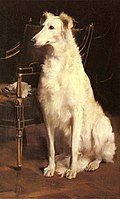
A Borzoi by a Chair, by

Die Suffragette

Louis Vorow Zborrowski by Julian Russell Story (1857-1919)
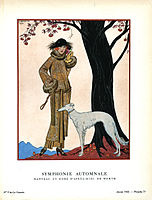
George Barbier depicting a woman with a Borzoi in La Gazette
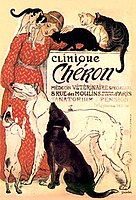
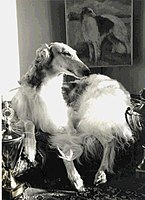
A Borzoi with a Borzoi picture behind.
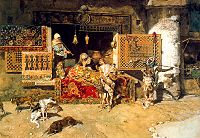
El venedor de tapissos, The carpet handler.
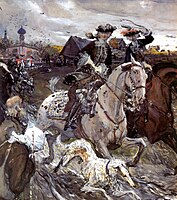
Painting by Valentin Alexandrovich Serov

Borzoi by Frances C. Fairman, circa 1900
See also[]
- Dogs portal
- List of dog breeds
References[]
Citations[]
- ^ Jump up to: a b "Borzoi". American Kennel Club. Retrieved 29 November 2018.
- ^ "Borzoi". Dictionary. Retrieved 26 April 2014.
- ^ "Definition of Borzoi in Oxford dictionary (British & World English)". Oxford dictionary. Retrieved 26 April 2014.
- ^ "theborzoiclub.org.uk". theborzoiclub.org.uk. Retrieved 26 April 2014.
- ^ "Borzoi Colors and Markings". American Kennel Club. Retrieved 19 March 2012.
- ^ "The Borzoi Standard". Borzoi Club of America. Archived from the original on 7 March 2012. Retrieved 19 March 2012.
- ^ Scott 2002, p. 113
- ^ Brunarski/Moyer. "lyric". Nktelco.net. Retrieved 23 May 2012.
- ^ "Borzoi Club of America, Inc". Borzoiclubofamerica.org. Archived from the original on 29 February 2012. Retrieved 23 May 2012.
- ^ "NZKC - Breed Standard - Borzoi". New Zealand Kennel Club. Retrieved 3 November 2011.
- ^ "Borzoi: Dog Breed Selector: Animal Planet". Animal Planet. Retrieved 3 November 2011.
- ^ "Individual Breed Results for Purebred Dog Health Survey".
- ^ [1] Archived 14 February 2012 at the Wayback Machine
- ^ Glickman L, Glickman N, Schellenberg D, Raghavan M, Lee T (2000). "Non-dietary risk factors for gastric dilatation-volvulus in large and giant breed dogs". J. Am. Vet. Med. Assoc. 217 (10): 1492–9. doi:10.2460/javma.2000.217.1492. PMID 11128539. S2CID 22006972.
- ^ "Borzoi Dog Breed Information". American Kennel Club. Retrieved 4 May 2019.
- ^ Animal-World. "Borzoi". Animal World. Archived from the original on 1 June 2018. Retrieved 1 June 2018.
- ^ Scott 2002, p. 10
- ^ Scott 2002, p. 14
- ^ Tolstoy, Leo (2001). War and Peace. Wordsworth Classics. ISBN 1-85326-062-2.
- ^ Fitzgerald, F. Scott (1922). The Beautiful and Damned. Serenity Publishers. pp. 91–92. ISBN 9781604506259.
- ^ "Photographic image of owner and dog in matching pink coloration". Worldofthenerdonline.com. Archived from the original (JPG) on 1 December 2016. Retrieved 11 December 2017.
- ^ "The Borzoi Club of Queensland Inc". Borzoiclubqld.com. Retrieved 26 April 2014.
- ^ Pink Floyd. "Mademoiselle Nobs". YouTube. Retrieved 26 April 2014.
- ^ Towles, Amor (2016). A Gentleman in Moscow. New York, New York: Viking Inc. p. 111. ISBN 9780670026197.
Works cited[]
- Scott, Dr. Desiree (2002). Borzoi. PetLove. Dorking, Surry, UK: Interpet Publishing, UK. ISBN 1-903098-93-9.
General references[]
- Chadwick, Winifred E. (1952). The Borzoi Handbook. London: Nicholson & Watson. Including a translation of The Perchino Hunt by His Excellency Dmitri Walzoff (1912).
- Martin, Nellie L. (2005). Borzoi—The Russian Wolfhound: Its History, Breeding, Exhibiting and Care. Read Books. ISBN 978-1-84664-042-1.
- McRae, Gail C. (1989). Borzoi (New ed.). TFH Publications. ISBN 978-0-86622-676-9.
- Savenkova, V. (2003). Russkaya Psovaya Borzaya. Moscow. ISBN 978-5170169740.
External links[]
| Wikimedia Commons has media related to Borzoi. |
- Hounds
- Dog breeds originating in Russia
- FCI breeds
- Sighthounds
- Wolf hunting















